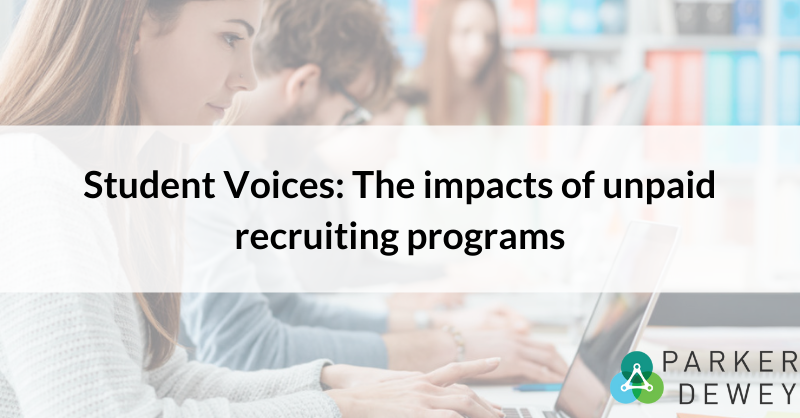.png)
The Myths of Micro-Internships
Whether you call them Micro-Internships, Mav Micros, SPRINTernships, project-based internships, or freelance gigs for college students, more organizations are recognizing the profound impacts of work-integrated learning.
While internships (and apprenticeships, job shadowing, etc.) aren’t new, organizations that are looking for programs that drive meaningful impacts on diversity, equity, and inclusion are quickly realizing the limitations of “traditional” programs: candidates are filtered our based upon academic pedigree, limited opportunities for career exploration, requirements for prior professional experience, not all students can afford to do free work or put commitments on-hold for 10-12 weeks… As a result and in spite of hiring technology advances, candidates with the skills to succeed are regularly screened-out or don’t even apply.
So how do organizations complement their existing hiring process with new methods to engage and assess diverse applicants? How do they put action behind their words to embrace skills-based hiring for early-career roles?
It doesn’t have to be complicated. It just has to be equitable, accessible, and most importantly, work. That’s where Micro-Internships fit in.
In fact, including Micro-Internships as part of a campus recruiting process takes less time than traditional screening processes, especially when you consider the real-work being completed. They don’t require prior experience or deep industry expertise. Instead, Micro-Internships enable career launchers from all backgrounds, circumstances, and locations to learn what it’s like to work at your organization while gaining real, paid, professional experience.
And it’s not just first-generation college students, student-athletes, and those underrepresented in the workforce that benefit. High-volume teams too busy to attend a career fair benefit from on-demand support. Hiring managers with preconceived notions on what major/school/GPA makes their “perfect” hire benefit when they see a candidate they wouldn’t normally have considered in action. Employer brands directly benefit by demonstrating their commitment to equity and inclusion by providing alternative pathways into their organization.
And unlike so many other aspects to recruiting, it doesn’t require a big cost or commitment to see the impact. So what are you waiting for? There’s never been a better time to get on-demand support for your growing to-do list, while providing an opportunity for a college student to gain experience.
Michele Aymold, Vice President
Articles of the Week
The Secret Life of English Majors - Washington Monthly
Liberal Arts Colleges Must be Partners in Workforce Development - The Hechinger Report
Automated Hiring Software is Mistakenly Rejecting Millions of Viable Job Candidates - The Verge
The Secret Life of English Majors - Washington Monthly
“How is it that UT humanities majors overcome the racial earnings gap? There’s no one clear answer. But there seem to be multiple possible explanations that could help students, instructors, institutions, and employers everywhere—and across all disciplines—reduce pay discrimination.”
Data collected by the University of Texas suggests that Black and brown humanities graduates make similar wages to their white counterparts, both right after graduation and 15 years down the line. These findings contrast sharply with comparable data around computer science, engineering, and business graduates, where massive salary inequities are far more common. One contributing reason: the humanities “breed resilience, creativity, and interdisciplinary thinking, which enable graduates to capitalize on new opportunities in the workforce that students trained in narrower disciplines might not recognize or pursue.” This piece digs into the value of the humanities and some of the equity lessons that both universities and companies can take from this data.
Related reading: Why Early-Career Recruiting Matters in the Talent Shortage
Liberal Arts Colleges Must be Partners in Workforce Development - The Hechinger Report
“Specialized technical and professional skills are a clear ramp to jobs in innovation. But it’s liberal arts meta-skills (so-called soft skills) that fuel how far our students can go. These meta-skills drive our ability to work flexibly and innovate throughout our careers. Curiosity, creativity, critical analysis, experimentation, collaboration, empathy and communication all drive innovation.”
While the liberal arts are often positioned as an alternative to technology, science, and business programs, they should actually be considered a complement. Broadly-educated, widely-skilled students are not only knowledgeable in multiple areas—they’re adaptable, creative, and primed for ongoing learning. This piece lays out three reasons why liberal arts institutions should be a key partner in “reimagining our country’s workforce and addressing urgent issues facing society.”
In fact, Purdue University’s College of Liberal Arts’ Cornerstone program was highlighted for its work in this area by the Teagle Foundation and the National Endowment for the Humanities.
Related reading: How Micro-Internships Bridge the Core Skills Gap
Automated Hiring Software is Mistakenly Rejecting Millions of Viable Job Candidates - The Verge
“The exact mechanics of how automated software mistakenly reject candidates are varied, but generally stem from the use of overly-simplistic criteria to divide ‘good’ and ‘bad’ applicants.”
What happens when companies rely on automated resume-scanning software? A “broken” hiring system that mistakenly filters out millions of candidates for less-than-logical reasons, like a gap in employment (what if a candidate was caring for a sick relative?) or lack of experience in a specific area (what if a candidate has 10+ years of skills learned in another field and is making a career pivot?). This piece also backs up the fact that resumes aren’t a true indicator of someone’s work ethic, skills, or growth potential—and that’s where Micro-Internships can serve as a more accurate and more equitable alternative.
Related reading: Why It's Time to Ditch "Static and Monolithic" Hiring Assessments
For more stories and insights on HR, recruiting, and diversity, click here to subscribe to our weekly newsletter Hire Learnings.


.png)
.png)
